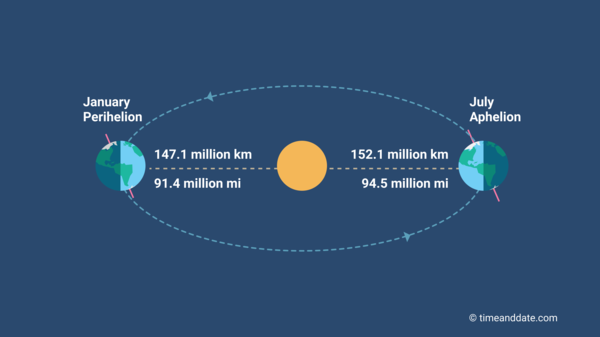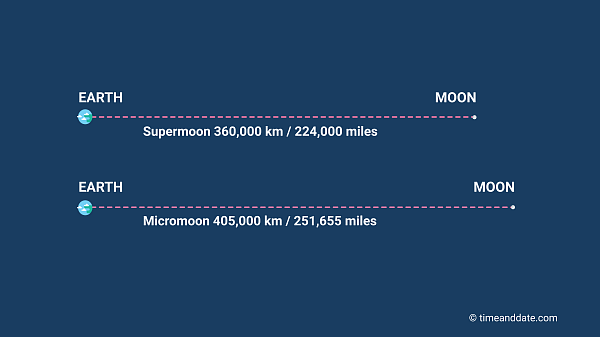Shortest Lunar Month 2024 Begins at Third Quarter on May 30
The monthly cycles of Moon phases contain hidden patterns that can only be revealed by diving into the data. Minor complication: this is an example of a three-body problem.
June 28: Closest Quarter Moon This Year
The end of 2024’s shortest lunar month—from May 30 to June 28—coincides with this year’s closest Quarter Moon.
When the Moon reaches Third Quarter at 21:53 UTC on June 28, the center of the Moon will be about 369,873 km (229,828 miles) from the center of the Earth.
This distance is particularly close for a Quarter Moon, although it’s not as close as a Supermoon (which can only occur when the Earth, Moon, and Sun are in alignment at New or Full Moon).

The period between consecutive appearances of the same Moon phase is called a synodic month. The time between the next two Third Quarter Moons—on May 30 and June 28—will be the shortest synodic month of 2024.
©Brendan Goodenough/timeanddate.com
Moon to Race through Its Phases
On average, the Moon takes 29.53 days to cycle through all of its phases. This period of time is called a synodic month or a lunation.
But no two lunar months are exactly the same.
Starting at Third Quarter Moon on May 30, 2024, the Moon will race through its cycle of phases in 29.19 days—around 8 hours and 10 minutes faster than average, and the shortest lunar month of the year.
Shortest Synodic Month 2024: May 30 to June 28
| Date | Time (UTC) | Phase |
|---|---|---|
| May 30 | 17:12 | Third Quarter |
| June 6 | 12:37 | New Moon |
| June 14 | 05:18 | First Quarter |
| June 22 | 01:07 | Full Moon |
| June 28 | 21:53 | Third Quarter |
Sources: timeanddate.com; JPL DE430
Factors That Affect the Length of a Lunar Month
The orbits of planets and moons are not perfect circles, and the orbital speeds of celestial bodies are continuously changing.
These variations influence the length of the lunar month in a number of ways; three are listed below.
None of these patterns are noticeable as we watch the Moon wax and wane in the sky, but they can be revealed by looking at data.
1. Earth’s Distance from the Sun


As is the case with all the planets, Earth’s orbit around the Sun is not a perfect circle. (Technically speaking, it is an ellipse with the Sun at one focus.)
©timeanddate.com
To cycle through all its phases, the Moon has to complete one orbit of the Earth plus a little bit extra. Why? As the Moon orbits the Earth, the Earth orbits the Sun—meaning the Moon has to travel an extra distance to return to the same phase as the previous month.
The farther Earth is from the Sun, the slower it moves along its orbit, and the less extra distance the Moon has to travel. As a result, the lunar month is slightly shorter.
Earth reaches its farthest point from the Sun during the first week of July. This point is called aphelion.
In 2024, aphelion is on July 5 at 05:06 UTC—close to the end of the shortest synodic month.
2. The Moon’s Distance from Earth
Once every month, the Moon reaches its closest point to Earth, called perigee. The period of time from one perigee to the next is known as an anomalistic month.
The average length of an anomalistic month is 27.55 days—which is a bit shorter than the time it takes the Moon to cycle through all of its phases. It’s possible, therefore, for the Moon to pass close to Earth twice during the same synodic month: once at the beginning, and again at the end.
This leads to a shorter lunar month, because the Moon orbits more quickly when it is close to Earth.
The shortest synodic month of 2024 contains two perigees, one on June 2 at 07:16 UTC, the other on June 27 at 11:30 UTC.
3. The Length of the Anomalistic Month
Over the course of a year, the most extreme perigees happen around New Moon or Full Moon, when the Earth, Moon, and Sun are in alignment.
These events are commonly referred to as Supermoons (when the Moon is especially close) and Micromoons (when it is especially far away).
If we look only at synodic months that begin and end at New Moon, the shortest lunar months coincide with Supermoons, when the Moon is traveling at its maximum orbital speed.


There is no single definition of a Supermoon. At timeanddate, we define it as when the center of the Moon is less than 360,000 kilometers (about 224,000 miles) from the center of Earth.
timeanddate.com
However, the shortest synodic months overall begin and end with a First or Third Quarter Moon, where the gravitational effects of the Sun are smaller—even though the perigees are not as ultra-close as those at New Moon.
The reason why lunations starting at Quarter Moon win out is because they can be associated with notably short anomalistic months of roughly 25 days—around two or three days shorter than average. This smaller spacing between perigees leads to a higher average orbital speed for the Moon.
Although it’s not an exact match every year, the shortest anomalistic month in 2024—25.18 days, from June 2 to June 27—coincides perfectly with the shortest synodic month (29.19 days, from May 30 to June 28).
Earth + Moon + Sun = Three-Body Problem
The motions of the Earth, Moon, and Sun are well understood and extremely predictable for most purposes.
But there is a complication that affects any detailed analysis: the Earth, Moon, and Sun interact gravitationally with each other in a way that, ultimately, is chaotic.
“This is an example of the three-body problem,” says timeanddate’s Frank Tveter, who received his doctorate in celestial mechanics from the University of Oslo in Norway.
“There are no general simple solutions to the three-body problem—something that has enticed the minds of the famous mathematicians Newton, Euler, Bernoulli, Laplace, Lagrange, Poincaré, and others.”

The Netflix TV series 3 Body Problem—released in March 2024, and based on a novel by Cixin Liu—has popularized the three-body problem, a fundamental concept in celestial mechanics. Image provided courtesy of Netflix.
©Netflix, Inc.